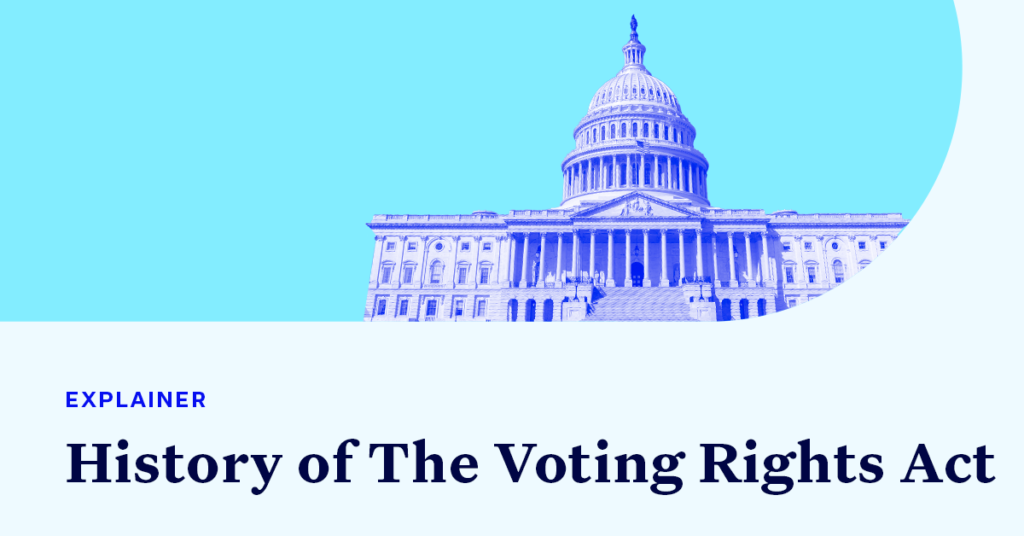The Voting Rights Act: How We Got Here

To understand the history of the Voting Rights Act (VRA), we have to go back to the foundation of almost all progressive movements in America: Black activists.
For decades, Black voters were systematically disenfranchised. Even after the 15th Amendment prohibited states from denying or abridging any citizen from voting “on account of race, color, or previous condition of servitude,” many states continued to enforce racist and violent practices to prevent Black people from voting.
The right to vote became a major focus of the civil rights movement. Following the Civil Rights Act of 1964, civil rights organizations like the Southern Christian Leadership Council (SCLC) and the Student Nonviolent Coordinating Committee (SNCC) led a massive effort to register Black voters in the South. They made Selma, Alabama the center of this registration campaign, largely because Selma’s local county sheriff openly opposed Black voter registration drives. This intimidation led to systematic disenfranchisement: only 2% of eligible Black voters in Selma were registered to vote.
This set the stage for the Selma to Montgomery March and the infamous Bloody Sunday. On Sunday, March 7, 1965, a group of peaceful demonstrators (including John Lewis) were attacked by Alabama state troopers. The horrific violence was caught on television and broadcast across the country. Ten days later, President Lyndon Johnson asked Congress to pass a federal voting rights bill to address barriers that prevented Black voters from casting their ballots.
This legislation became the Voting Rights Act of 1965, signed into law in August of that year. The VRA included a host of provisions intended to enforce the 15th Amendment and ensure Black voters were not disenfranchised. The Act banned the use of literacy tests, which forced Black people attempting to register to take unfair tests that were designed for them to fail. The VRA also created a new requirement for specific states with a history of suppressing Black voters that prohibited these states and localities from enacting changes to their election laws without getting “preclearance” from either the U.S. Department of Justice or the U.S. District Court for the District of Columbia.
The impact of the VRA was felt immediately. Black voter registration soared: By the end of 1965, 250,000 new Black voters were registered to vote. Black political power also grew thanks to the VRA. For example, the number of Black elected officials in Georgia grew from three in 1965 to 495 in 1990. One year after the VRA was signed, the U.S. Supreme Court added another protection for Black voters in Harper v. Virginia Board of Elections, ruling that poll taxes violated the 14th Amendment.
In 1970, President Richard Nixon signed an extension of the VRA, starting a bipartisan trend of extending the legislation that lasted for 40 years. Over the past decade, however, Republicans’ support for the VRA has eroded. In 2011, southern states were routinely brought to court by the Department of Justice over their restrictive voting laws that disproportionately impacted minority voters. To make matters worse, Section 5, the heart of the VRA, was effectively struck down in the 2013 U.S. Supreme Court case Shelby County v. Holder. Since then, Republicans have doubled down on their suppression of minority voters, introducing more restrictive election laws every year. While there are many aspects of the VRA that still protect Black and other minority voters, the strength of the legislation has been significantly undermined since its enactment, as equal access to the ballot box is repeatedly attacked.
The state of voting rights in this country is concerning — but there are signs of hope. The VRA established a vital foundation and gives us a guide for what significant, lasting and equitable voting rights reform can look like at the federal level. Today, our new Democratic majority knows the urgency of such legislation — and is working on some of the most substantial revisions to the VRA ever introduced.
The VRA lives on through voting rights activists across the country who are continuing the efforts from 1965, challenging suppressive election laws in court and fighting for the fundamental right to cast a ballot and have it counted.